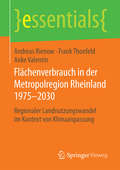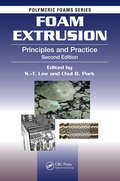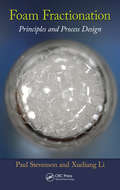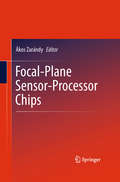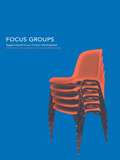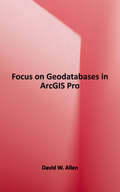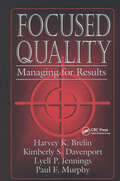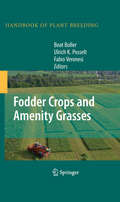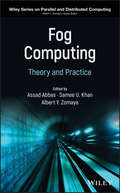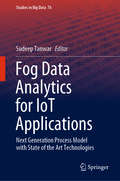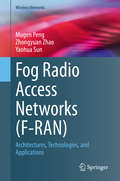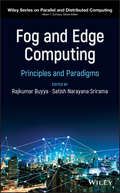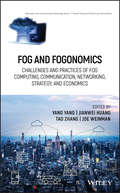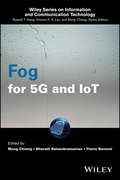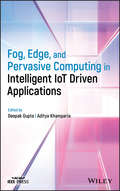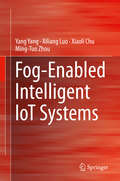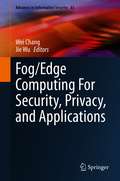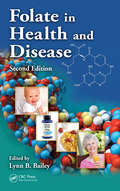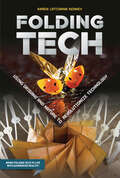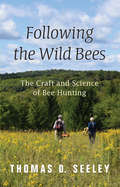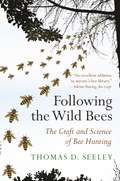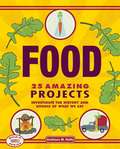- Table View
- List View
Flächenverbrauch in der Metropolregion Rheinland 1975–2030: Regionaler Landnutzungswandel im Kontext von Klimaanpassung (essentials)
by Andreas Rienow Frank Thonfeld Anke ValentinDie Autoren schaffen mit der Entwicklung kleinräumiger Lösungen zum Umgang mit dem Landnutzungs- und Klimawandel Verständnis und Bewusstsein beim Leser und bieten auf diese Weise eine gute Basis für politisches Handeln. Sie zeigen, dass zunächst die Bauleitplanung in der Pflicht ist, wie es in vielen lokalen Klimaanpassungskonzepten nachzuvollziehen ist. Aber auch die Zivilbevölkerung kann ihren Beitrag zu einer klimaangepassten Gestaltung unserer Umwelt leisten. Politik und Verwaltung können Vorgaben für neu geplante Gebäude geben, die sich an den Erkenntnissen orientieren, die über Fernerkundungsdaten und Klimamodelle erzielt werden. Gerade die nach außen orientierte Siedlungsentwicklung der letzten Jahrzehnte wird über den Blick auf die klassifizierten Satellitenbilder erschreckend gut sichtbar.
Foam Engineering
by Paul StevensonContaining contributions from leading academic and industrial researchers, this book provides a much needed update of foam science research. The first section of the book presents an accessible summary of the theory and fundamentals of foams. This includes chapters on morphology, drainage, Ostwald ripening, coalescence, rheology, and pneumatic foams.The second section demonstrates how this theory is used in a wide range of industrial applications, including foam fractionation, froth flotation and foam mitigation. It includes chapters on suprafroths, flotation of oil sands, foams in enhancing petroleum recovery, Gas-liquid Mass Transfer in foam, foams in glass manufacturing, fire-fighting foam technology and consumer product foams.Key features:Foam fractionation is an exciting and emerging technology, starting to gain significant attentionDiscusses a vital topic for many industries, especially mineral processing, petroleum engineering, bioengineering, consumer products and food sectorLinks foam science theory to industrial applications, making it accessible to an engineering science audienceSummarizes the latest developments in this rapidly progressing area of researchContains contributions from leading international researchers from academia and industry
Foam Extrusion: Principles and Practice, Second Edition (Polymeric Foams)
by Chul B. Park S. T. LeeCombining scientific principles with engineering practice, this book discusses the theory, design, processing, and application of degradable foam extraction; presents the collective expertise of leading academic, research, and industry specialists; and captures the interesting evolution of the field. Containing updated chapters on extrusion equipment, blowing agents, PET foam, and microcellular innovation, the second edition includes new chapters on the latest developments in processing, rheology, and biodegradable and sustainable foams, as well as new coverage of cutting-edge foaming mechanisms and new case studies, examples, and figures.
Foam Fractionation: Principles and Process Design
by Xueliang Li Paul StevensonFoam fractionation is a separation process in which proteins and other amphipathic species adsorb to the surface of bubbles. The bubbles are then removed from the solution in the form of foam at the top of a column. Due to its cost-effectiveness, foam fractionation has the potential for rapid commercial growth, especially in biotechnology.To assist
Focal-Plane Sensor-Processor Chips
by Ákos ZarándyFocal-plane sensor-processor imager devices are sensor arrays and processor arrays embedded in each other on the same silicon chip. This close coupling enables ultra-fast processing even on tiny, low power devices, because the slow and energetically expensive transfer of the large amount of sensory data is eliminated. This technology also makes it possible to produce locally adaptive sensor arrays, which can (similarly to the human retina) adapt to the large dynamics of the illumination in a single scene This book focuses on the implementation and application of state-of-the-art vision chips. It provides an overview of focal plane chip technology, smart imagers and cellular wave computers, along with numerous examples of current vision chips, 3D sensor-processor arrays and their applications. Coverage includes not only the technology behind the devices, but also their near- and mid-term research trends.
Focus Groups: Supporting Effective Product Development
by Deana McDonagh Joe LangfordThe focus group is widely used to as a tool for increasing the understanding of users and their requirements, and identifying potential solutions for these requirements. Its main value lies in the conveyance of less tangible information that cannot be obtained using more traditional methods. Eliciting user needs beyond the functional is crucial for
Focus on Geodatabases in ArcGIS Pro (Focus On)
by David W. AllenThis book introduces readers to the geodatabase, the comprehensive information model for representing and managing geographic information across the ArcGIS platform. Sharing best practices for creating and maintaining data integrity, chapter topics include the careful design of a geodatabase schema, building geodatabases that include data integrity rules, populating geodatabases with existing data, working with topologies, editing data using various techniques, building 3D views, and sharing data on the web. Each chapter includes important concepts with hands-on, step-by-step tutorials, sample projects, and datasets, 'Your turn' segments with less instruction, study questions for classroom use, and an independent project. Instructor resources are available by request.
Focused Quality: Managing for Results
by Paul MurphyFocused Quality: Managing for Results is a book about using quality improvement as a means to enhance bottom line results. Written for managers in industry, services, healthcare and government, this important new book provides a focused approach on how to target critical improvement initiatives and insure their success.Prepare - Plan - Deploy - Transition are the steps in the improvement process that are covered in detail. Included are examples of how organizations have successfully accomplished each step. Practical lessons on how to and how not to implement quality and process improvement initiatives are given.Process assessment is crucial to identifying the importance of a process and defining the scope of what is involved in order to improve it. Before deciding to refine, redesign or reengineer an assessment is needed. Focused Quality: Managing for Results not only shows you how to do an assessment but also how to apply the results to improve the bottom line.Application is emphasized throughout the book with the focus on the managers role in leading the change effort. The authors have provided a set of questions that management should answer to determine if their organization is ready to effectively implement the improvement process. Realizing that even the best plans can go astray there is also a diagnostic check sheet to pinpoint the causes of and solutions for process improvement failures.
Fodder Crops and Amenity Grasses
by Fabio Veronesi Ulrich K. Posselt Beat BollerThe main role of grasses, clovers and alfalfa in temperate agriculture is still to provide forage for ruminant animals but, in the last decades, the importance of amenity grasses increased markedly and, in the near future, new developments in the areas of energy and biomass use can be envisaged. Fodder Crops and Amenity Grasses, fifth volume in the series, Handbook of Plant Breeding, covers all these aspects. Most fodder crops and amenity grasses are perennials and many of them are natural or induced polyploids. Thus, breeding procedures and strategies differ greatly from breeding annual field crops. Breeding objectives are more difficult to define in forage crops because direct measurement of the efficiency of animal production during breeding and variety assessment is impractical. As a result, a large number of selection criteria have been developed for the particular crops. However, breeding objectives and methodology have a common basis among these species and are therefore presented in the general chapters. Particular emphasis is placed on the breeding methodology for cross-pollinating species because the large majority of crops belong to this group. In addition, the potential of new molecular techniques to complement breeding concepts and strategies is presented and critically discussed. Special techniques and procedures as well as particular breeding goals will be included in the crop specific chapters. Amenity grass breeding has its own breeding objectives and testing procedures, however, the species are mostly the same as in forage grass breeding, and crop specific chapters will include the amenity aspects where appropriate. The crop specific chapters will cover the range of topics given in the guidelines below. The volume on Fodder Crops and Amenity Grasses is the fifth volume in series Handbook of Plant Breeding after the initial volumes on Vegetables, Cereals, Oil Crops and Fruits. Like the other volumes in the series, the volume presents information on the latest scientific information in applied plant breeding using the current advances in the field, from efficient use of genetic resources to impact of biotechnology in plant breeding. Outstanding scientists from all over the world have contributed chapters to the work.
Fog Computing for Healthcare 4.0 Environments: Technical, Societal, and Future Implications (Signals and Communication Technology)
by Sudeep TanwarThis book provides an analysis of the role of fog computing, cloud computing, and Internet of Things in providing uninterrupted context-aware services as they relate to Healthcare 4.0. The book considers a three-layer patient-driven healthcare architecture for real-time data collection, processing, and transmission. It gives insight to the readers for the applicability of fog devices and gateways in Healthcare 4.0 environments for current and future applications. It also considers aspects required to manage the complexity of fog computing for Healthcare 4.0 and also develops a comprehensive taxonomy.
Fog Computing: Theory and Practice (Wiley Series on Parallel and Distributed Computing)
by Albert Y. Zomaya Samee U. Khan Assad AbbasSummarizes the current state and upcoming trends within the area of fog computing Written by some of the leading experts in the field, Fog Computing: Theory and Practice focuses on the technological aspects of employing fog computing in various application domains, such as smart healthcare, industrial process control and improvement, smart cities, and virtual learning environments. In addition, the Machine-to-Machine (M2M) communication methods for fog computing environments are covered in depth. Presented in two parts—Fog Computing Systems and Architectures, and Fog Computing Techniques and Application—this book covers such important topics as energy efficiency and Quality of Service (QoS) issues, reliability and fault tolerance, load balancing, and scheduling in fog computing systems. It also devotes special attention to emerging trends and the industry needs associated with utilizing the mobile edge computing, Internet of Things (IoT), resource and pricing estimation, and virtualization in the fog environments. Includes chapters on deep learning, mobile edge computing, smart grid, and intelligent transportation systems beyond the theoretical and foundational concepts Explores real-time traffic surveillance from video streams and interoperability of fog computing architectures Presents the latest research on data quality in the IoT, privacy, security, and trust issues in fog computing Fog Computing: Theory and Practice provides a platform for researchers, practitioners, and graduate students from computer science, computer engineering, and various other disciplines to gain a deep understanding of fog computing.
Fog Data Analytics for IoT Applications: Next Generation Process Model with State of the Art Technologies (Studies in Big Data #76)
by Sudeep TanwarThis book discusses the unique nature and complexity of fog data analytics (FDA) and develops a comprehensive taxonomy abstracted into a process model. The exponential increase in sensors and smart gadgets (collectively referred as smart devices or Internet of things (IoT) devices) has generated significant amount of heterogeneous and multimodal data, known as big data. To deal with this big data, we require efficient and effective solutions, such as data mining, data analytics and reduction to be deployed at the edge of fog devices on a cloud. Current research and development efforts generally focus on big data analytics and overlook the difficulty of facilitating fog data analytics (FDA). This book presents a model that addresses various research challenges, such as accessibility, scalability, fog nodes communication, nodal collaboration, heterogeneity, reliability, and quality of service (QoS) requirements, and includes case studies demonstrating its implementation. Focusing on FDA in IoT and requirements related to Industry 4.0, it also covers all aspects required to manage the complexity of FDA for IoT applications and also develops a comprehensive taxonomy.
Fog Radio Access Networks: Architectures, Technologies, and Applications (Wireless Networks)
by Mugen Peng Zhongyuan Zhao Yaohua SunThis book provides a comprehensive introduction of Fog Radio Access Networks (F-RANs), from both academic and industry perspectives. The authors first introduce the network architecture and the frameworks of network management and resource allocation for F-RANs. They then discuss the recent academic research achievements of F-RANs, such as the analytical results of theoretical performance limits and optimization theory-based resource allocation techniques. Meanwhile, they discuss the application and implementations of F-RANs, including the latest standardization procedure, and the prototype and test bed design. The book is concluded by summarizing the existing open issues and future trends of F-RANs. Includes the latest theoretical and technological research achievements of F-RANs, also discussing existing open issues and future trends of F-RANs toward 6G from an interdisciplinary perspective; Provides commonly-used tools for research and development of F-RANs such as open resource projects for implementing prototypes and test beds;Includes examples of prototype and test bed design and gives tools to evaluate the performance of F-RANs in simulations and experimental circumstances.
Fog and Edge Computing: Principles and Paradigms (Wiley Series on Parallel and Distributed Computing)
by Rajkumar Buyya Satish Narayana SriramaA comprehensive guide to Fog and Edge applications, architectures, and technologies Recent years have seen the explosive growth of the Internet of Things (IoT): the internet-connected network of devices that includes everything from personal electronics and home appliances to automobiles and industrial machinery. Responding to the ever-increasing bandwidth demands of the IoT, Fog and Edge computing concepts have developed to collect, analyze, and process data more efficiently than traditional cloud architecture. Fog and Edge Computing: Principles and Paradigms provides a comprehensive overview of the state-of-the-art applications and architectures driving this dynamic field of computing while highlighting potential research directions and emerging technologies. Exploring topics such as developing scalable architectures, moving from closed systems to open systems, and ethical issues rising from data sensing, this timely book addresses both the challenges and opportunities that Fog and Edge computing presents. Contributions from leading IoT experts discuss federating Edge resources, middleware design issues, data management and predictive analysis, smart transportation and surveillance applications, and more. A coordinated and integrated presentation of topics helps readers gain thorough knowledge of the foundations, applications, and issues that are central to Fog and Edge computing. This valuable resource: Provides insights on transitioning from current Cloud-centric and 4G/5G wireless environments to Fog Computing Examines methods to optimize virtualized, pooled, and shared resources Identifies potential technical challenges and offers suggestions for possible solutions Discusses major components of Fog and Edge computing architectures such as middleware, interaction protocols, and autonomic management Includes access to a website portal for advanced online resources Fog and Edge Computing: Principles and Paradigms is an essential source of up-to-date information for systems architects, developers, researchers, and advanced undergraduate and graduate students in fields of computer science and engineering.
Fog and Fogonomics: Challenges and Practices of Fog Computing, Communication, Networking, Strategy, and Economics (Information and Communication Technology Series, #57)
by Yang Yang Joe Weinman Tao Zhang Jianwei HuangTHE ONE-STOP RESOURCE FOR ANY INDIVIDUAL OR ORGANIZATION CONSIDERING FOG COMPUTING Fog and Fogonomics is a comprehensive and technology-centric resource that highlights the system model, architectures, building blocks, and IEEE standards for fog computing platforms and solutions. The "fog" is defined as the multiple interconnected layers of computing along the continuum from cloud to endpoints such as user devices and things including racks or microcells in server closets, residential gateways, factory control systems, and more. The authors—noted experts on the topic—review business models and metrics that allow for the economic assessment of fog-based information communication technology (ICT) resources, especially mobile resources. The book contains a wide range of templates and formulas for calculating quality-of-service values. Comprehensive in scope, it covers topics including fog computing technologies and reference architecture, fog-related standards and markets, fog-enabled applications and services, fog economics (fogonomics), and strategy. This important resource: Offers a comprehensive text on fog computing Discusses pricing, service level agreements, service delivery, and consumption of fog computing Examines how fog has the potential to change the information and communication technology industry in the next decade Describes how fog enables new business models, strategies, and competitive differentiation, as with ecosystems of connected and smart digital products and services Includes case studies featuring integration of fog computing, communication, and networking systems Written for product and systems engineers and designers, as well as for faculty and students, Fog and Fogonomics is an essential book that explores the technological and economic issues associated with fog computing.
Fog for 5G and IoT
by Mung Chiang Bharath Balasubramanian Flavio BonomiThe book examines how Fog will change the information technology industry in the next decade. Fog distributes the services of computation, communication, control and storage closer to the edge, access and users. As a computing and networking architecture, Fog enables key applications in wireless 5G, the Internet of Things, and big data. The authors cover the fundamental tradeoffs to major applications of fog. The book chapters are designed to motivate a transition from the current cloud architectures to the Fog (Chapter 1), and the necessary architectural components to support such a transition (Chapters 2-6). The rest of the book (Chapters 7-xxx) are dedicated to reviewing the various 5G and IoT applications that will benefit from Fog networking. This volume is edited by pioneers in Fog and includes contributions by active researchers in the field. Covers fog technologies and describes the interaction between fog and cloud Presents a view of fog and IoT (encompassing ubiquitous computing) that combines the aspects of both industry and academia Discusses the various architectural and design challenges in coordinating the interactions between M2M, D2D and fog technologies “Fog for 5G and IoT” serves as an introduction to the evolving Fog architecture, compiling work from different areas that collectively form this paradigm Mung Chiang is the Arthur LeGrand Doty Professor of Electrical Engineering at Princeton University, the Director of the Keller Center for Innovations in Engineering Education, and the Chair of Princeton Entrepreneurship Advisory Committee. Dr. Chiang founded the Princeton EDGE Lab in 2009, which bridges the theory-practice gap in edge networking research by spanning from proofs to prototypes. He is the recipient of the 2013 Alan T. Waterman Award. Bharath Balasubramanian is a distributed systems researcher in the Cloud Software Research department at ATT Labs. Prior to this, he had a postdoc in the Electrical Engineering department at Princeton University working with Mung Chiang in the EDGE lab. Flavio Bonomi is a Cisco Fellow, Vice President, and is the Head of the Advanced Architecture and Research Organization at Cisco Systems.
Fog, Edge, and Pervasive Computing in Intelligent IoT Driven Applications
by Deepak GuptaA practical guide to the design, implementation, evaluation, and deployment of emerging technologies for intelligent IoT applications With the rapid development in artificially intelligent and hybrid technologies, IoT, edge, fog-driven, and pervasive computing techniques are becoming important parts of our daily lives. This book focuses on recent advances, roles, and benefits of these technologies, describing the latest intelligent systems from a practical point of view. Fog, Edge, and Pervasive Computing in Intelligent IoT Driven Applications is also valuable for engineers and professionals trying to solve practical, economic, or technical problems. With a uniquely practical approach spanning multiple fields of interest, contributors cover theory, applications, and design methodologies for intelligent systems. These technologies are rapidly transforming engineering, industry, and agriculture by enabling real-time processing of data via computational, resource-oriented metaheuristics and machine learning algorithms. As edge/fog computing and associated technologies are implemented far and wide, we are now able to solve previously intractable problems. With chapters contributed by experts in the field, this book: Describes Machine Learning frameworks and algorithms for edge, fog, and pervasive computing Considers probabilistic storage systems and proven optimization techniques for intelligent IoT Covers 5G edge network slicing and virtual network systems that utilize new networking capacity Explores resource provisioning and bandwidth allocation for edge, fog, and pervasive mobile applications Presents emerging applications of intelligent IoT, including smart farming, factory automation, marketing automation, medical diagnosis, and more Researchers, graduate students, and practitioners working in the intelligent systems domain will appreciate this book’s practical orientation and comprehensive coverage. Intelligent IoT is revolutionizing every industry and field today, and Fog, Edge, and Pervasive Computing in Intelligent IoT Driven Applications provides the background, orientation, and inspiration needed to begin.
Fog-Enabled Intelligent IoT Systems
by Xiaoli Chu Yang Yang Xiliang Luo Ming-Tuo ZhouThis book first provides a comprehensive review of state-of-the-art IoT technologies and applications in different industrial sectors and public services. The authors give in-depth analyses of fog computing architecture and key technologies that fulfill the challenging requirements of enabling computing services anywhere along the cloud-to-thing continuum. Further, in order to make IoT systems more intelligent and more efficient, a fog-enabled service architecture is proposed to address the latency requirements, bandwidth limitations, and computing power issues in realistic cross-domain application scenarios with limited priori domain knowledge, i.e. physical laws, system statuses, operation principles and execution rules. Based on this fog-enabled architecture, a series of data-driven self-learning applications in different industrial sectors and public services are investigated and discussed, such as robot SLAM and formation control, wireless network self-optimization, intelligent transportation system, smart home and user behavior recognition. Finally, the advantages and future directions of fog-enabled intelligent IoT systems are summarized. Provides a comprehensive review of state-of-the-art IoT technologies and applications in different industrial sectors and public servicesPresents a fog-enabled service architecture with detailed technical approaches for realistic cross-domain application scenarios with limited prior domain knowledgeOutlines a series of data-driven self-learning applications (with new algorithms) in different industrial sectors and public services
Fog/Edge Computing For Security, Privacy, and Applications (Advances in Information Security #83)
by Jie Wu Wei ChangThis book provides the state-of-the-art development on security and privacy for fog/edge computing, together with their system architectural support and applications. This book is organized into five parts with a total of 15 chapters. Each area corresponds to an important snapshot. The first part of this book presents an overview of fog/edge computing, focusing on its relationship with cloud technology and the future with the use of 5G communication. Several applications of edge computing are discussed. The second part of this book considers several security issues in fog/edge computing, including the secure storage and search services, collaborative intrusion detection method on IoT-fog computing, and the feasibility of deploying Byzantine agreement protocols in untrusted environments. The third part of this book studies the privacy issues in fog/edge computing. It first investigates the unique privacy challenges in fog/edge computing, and then discusses a privacy-preserving framework for the edge-based video analysis, a popular machine learning application on fog/edge. This book also covers the security architectural design of fog/edge computing, including a comprehensive overview of vulnerabilities in fog/edge computing within multiple architectural levels, the security and intelligent management, the implementation of network-function-virtualization-enabled multicasting in part four. It explains how to use the blockchain to realize security services. The last part of this book surveys applications of fog/edge computing, including the fog/edge computing in Industrial IoT, edge-based augmented reality, data streaming in fog/edge computing, and the blockchain-based application for edge-IoT. This book is designed for academics, researchers and government officials, working in the field of fog/edge computing and cloud computing. Practitioners, and business organizations (e.g., executives, system designers, and marketing professionals), who conduct teaching, research, decision making, and designing fog/edge technology will also benefit from this book The content of this book will be particularly useful for advanced-level students studying computer science, computer technology, and information systems, but also applies to students in business, education, and economics, who would benefit from the information, models, and case studies therein.
Folate in Health and Disease
by Lynn B. BaileyDuring the fifteen years since the bestselling first edition of Folate in Health and Disease was published, there have been thousands of new research studies related to folate and its role in health and disease. The second edition of the book uniquely bridges the gap between basic science and public health/clinical medicine.Presents Groundbreaking
Folding Tech: Using Origami and Nature to Revolutionize Technology
by Karen Latchana KenneySpace probes, self-assembling robots, crash-absorbing cars, and designer proteins all have one thing in common: their use of folding technologies. To develop these technologies, engineers are taking inspiration from an unusual source—origami, the ancient art of paper folding. Examine origami's origins, how it intersects with mathematics, and how it became a tool to solve some of the most complicated challenges in engineering, architecture, technology, and medicine today. Plus, get a close-up look at these technologies with two augmented reality images included in the book!
Following the Wild Bees: The Craft and Science of Bee Hunting
by Thomas D. SeeleyFollowing the Wild Bees is a delightful foray into the pastime of bee hunting, an exhilarating outdoor activity that used to be practiced widely but which few people know about today. Thomas Seeley, a world authority on honey bees, vividly describes the history and science behind this lost pastime and how anyone can do it. Following the Wild Bees is both a unique meditation on the pleasures of the natural world and a guide to the ingenious methods that compose the craft of the bee hunter.Seeley explains how one finds a patch of flowers humming with honey bees, captures and sumptuously feeds the bees, and then releases and follows them, step-by-step in whatever direction they fly, back to their secret residence in a hollow tree, old building, or abandoned hive. The bee hunter's reward is a thrilling encounter with nature that challenges mind and body while also giving new insights into the remarkable behavior of honey bees living in the wild.Drawing on decades of experience as a bee hunter and bee biologist, Seeley weaves informative discussions of the biology of wild honey bees with colorful historical anecdotes, personal insights, and beautiful photos. Whether you're a bee enthusiast or just curious about the natural world, Following the Wild Bees is the ideal companion for newcomers to bee hunting and a rare treat for armchair naturalists.
Following the Wild Bees: The Craft and Science of Bee Hunting
by Thomas D. SeeleyA how-to book on an exhilarating outdoor activity and a unique meditation on the pleasures of the natural worldFollowing the Wild Bees is a delightful foray into the pastime of bee hunting, an exhilarating outdoor activity that used to be practiced widely but which few people know about today. Weaving informative discussions of bee biology with colorful anecdotes, personal insights, and beautiful photos, Thomas Seeley describes the history and science behind this lost pastime and how anyone can do it. The bee hunter’s reward is a thrilling encounter with nature that challenges mind and body while also giving insights into the remarkable behavior of honey bees living in the wild. Whether you’re a bee enthusiast or just curious about the natural world, this book is the ideal companion for newcomers to bee hunting and a rare treat for armchair naturalists.
Fondamenti di Ingegneria del Traffico
by Raffaele Mauro Marco GuerrieriQuesto libro tratta una selezione di argomenti fondamentali dell'ingegneria del traffico utili per la progettazione e il controllo delle strutture autostradali. La trattazione è concisa, ma non trascura di esaminare gli aspetti teorici più recenti e cruciali che sono alla base di numerose applicazioni dell'ingegneria autostradale, come, ad esempio, gli aspetti essenziali del calcolo dell'affidabilità dei flussi di traffico autostradale e del controllo automatizzato dei sistemi autostradali. Per rendere questi argomenti più facili da seguire, vengono forniti numerosi esempi di applicazioni lavorative, che vengono illustrate in modo molto dettagliato. In tutti i contenuti è stato adottato uno stile intuitivo e discorsivo, piuttosto che formale.Il libro offre quindi conoscenze pratiche e aggiornate su diversi aspetti dell'ingegneria del traffico, che interessano un ampio pubblico di studenti, ricercatori, pianificatori dei trasporti, specialisti del trasporto pubblico, urbanisti e decisori.
Food
by Farah Rizvi Kathleen M. ReillyFrom the minute life begins, food makes you strong, helps you grow, and gives you energy. But do you take that ham sandwich for granted? You might not give a lot of thought to where your food comes from, how it got to you, what's really in it, or what it does for you. Food: 25 Amazing Projects Investigate the History and Science of What We Eat gives kids some "food for thought" as they dive into exciting projects about the incredible world of food. Kids will have fun learning about all aspects of food in our daily lives-how vegetarians balance their diet, how some cultures rose and fell based on a single food source, the route from farm to market, how eating locally makes an impact, and much more.
